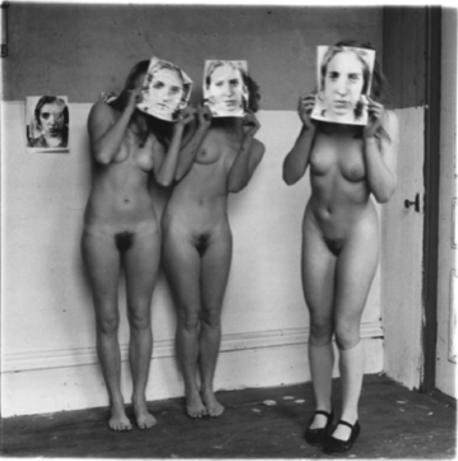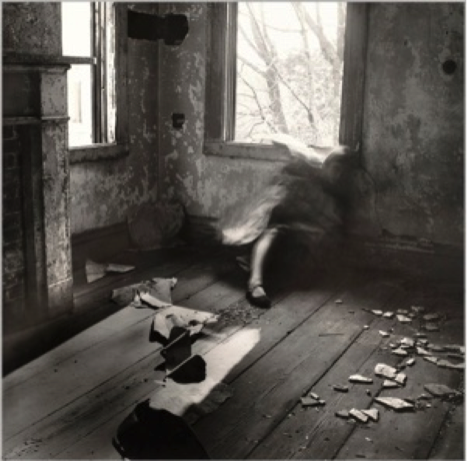On the Verge of Disappearance
June 2014.
Performing Identities[1]
Francesca Woodman (1958-1981) remains, after thirty-three years of her death, a singular voice in Feminism. Her photographs shifted the notions of self-portraiture by questioning subjectivity that culminates on new constructions of meanings of the represented body beyond the realm of beauty, sexuality and the patriarchal-sexist-racist demands and expectations. Corey Keller[2] states in his essay A Portrait of the Artist as a Young Woman:[3] “Her art is inward looking, experimental, and incomplete”. My understanding of Incomplete lies upon how semantics and sign systems she creates in her works become the illimitable exploration of the phenomenological being.
Woodman self-portraiture is complex, ambiguous and beautiful. She played with the idea of structuring the gaze and its fetishism potential through simulation, lack and loss of the young fresh body. By playing dead, the body opens the work for the performative and animates the discourse of inter-subjectivity. “Woodman is never quite with us, never quite with herself,” says Jovana Stokic,[4] in her essay Gender Check: Performing Identities. The photographer, performing her own masks of reality, is perpetually present in her works but always on the verge of quitting and disappearing.

Each of Woodman’s photos is an event on the verge of immateriality. For instance, death and loss does not have to take place necessarily, unless the viewer wishes to do it in his own imagination. Those performances were about engagement and mutual construction of meanings between the artist and the viewer, one contingent upon the other. In her intimate settings, Woodman performs for her multiple selves that overflow upon us. In its most concrete form, the conflict of not been quite with us and with herself, is the pure “tortured corporeality”, says Stokic. The body becomes objectified, a mass that can be distorted, manipulated, merged and erased, just to be canonized through a medium and an image for the other’s gaze.
How does disappearance plays out in my own practice as a concept? It opens room for the making of contingency in performance and writing, as the contingency refers to a future event that is possible, but cannot be predicted with certainty. It is dependent on chance or on the realization of the condition and the viewer is left with multiple outcomes. In the essay Three figures of Contingency,[5] Robin Mackay claims that contingency can only be grasped as an event and “we are all products of contingent events, webs and networks of anonymous forces”. By privileging contingency, instead of chance, the artist is able to challenge systems of thought that subordinate events to a predestined outcome or prediction. The emphasis on chance brings the viewer into the work as an event as interpretative exchange.
What is Crumbling: The Self or the Walls?
Woodman plotted and sketched her works in advance. Her best shots were the one she discoursed with the environment and her own imagination. I argue that by creating a deep and intrinsic relationship with the architecture, nature and objects around her, she fused herself with space and things. Paradoxically, she brings the question of the body and the self to the surface. Nudity for Woodman does not consume itself or resume in beauty and sexuality.
Woodman’s treatment of self-portraiture relies upon the complexity of the female soul and what lies underneath of the skin. Corey Keller later concludes in the very same essay, “Nudity is also clearly a state of being unclothed, of shedding the signifiers of identity as it is projected through clothing.” Her works, yet very specific to womanhood, expands to the questioning of the roles the female in relation to male desires and expectations that no always can be fulfilled. Presence and absence blurs—the “self” dissipates in the quotidian. In her photographs, the body becomes, by time and hybridization, the other and a thing, until it is no longer possible to distinguish bone from pilars, flesh from walls. Art becomes a free space of experimentation where the performative gives a room to breath for the question of disappearance, framed in time, as an eternal recurrence.
[1] The Essay Gender Check: Performing Identities/Francesca Woodman/Anagrammatic Bodies, by Jovana Stokic, inspired the subtitle “Performing Identities”.
[2] Corey Keller is the curator of photography at the San Francisco Museum of Modern Art (SFMOMA). She joined the museum in 1999 and held a number of positions before she was promoted to her current role in 2012. Keller organized the major retrospective exhibition of photographer Francesca Woodman (2011), which traveled to the Solomon R. Guggenheim Museum in New York in 2012.
[3] Corey Keller, A portrait of the Artist as a Young Woman, San Francisco: San Francisco Museum of Modern Art, 2013.
[4] Jovana Stokic is a Belgrade-born, New York-based art historian, critic and curator. She holds a PhD from the Institute of Fine Arts at the New York University. Her dissertation analyzes works of several women artists – Marina Abramovic, Martha Rosler, Joan Jonas — since the 1970s, particularly focusing on the notions of self-representation and beauty. Jovana has been writing art criticism for several years, and has curated several thematic exhibitions and performance events in the US, Italy, Spain and Serbia. Jovana was a fellow at the New Museum of Contemporary Art, New York, a researcher at the Whitney Museum of American Art, New York, and the curator of the Kimmel Center Galleries, New York University. She has most recently written an essay for Marina Abramovic’s MoMA exhibition catalogue.
[5] Robin Mackay,The Medium of Contingency, London: Urbanomic and Ridinghouse, 2011
Francesca Woodman |House #3 | 1976
Francesca Woodman |Untitled | Providence, Rhode Island, 1976
